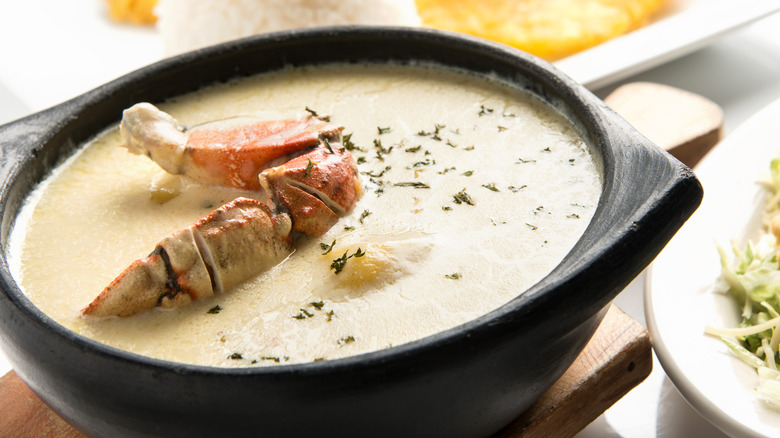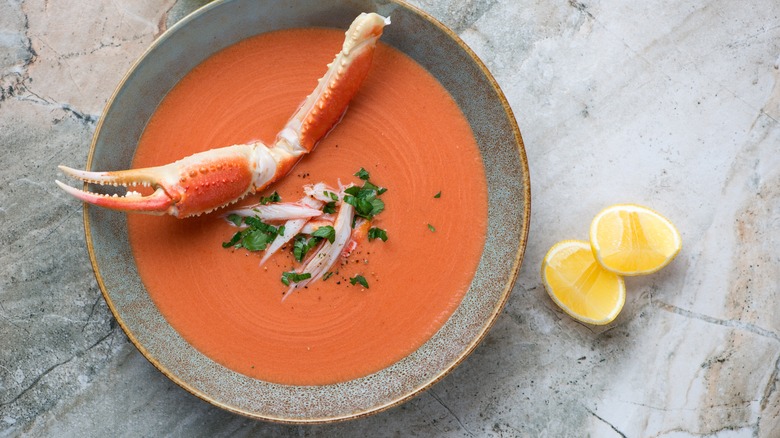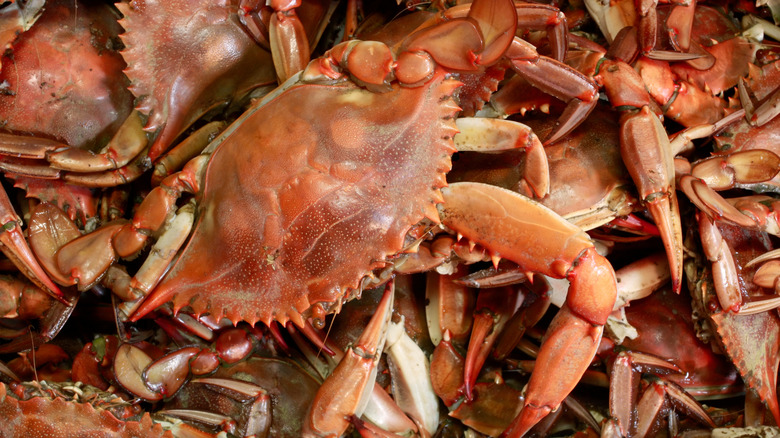Is She-Crab Soup Really That Different From Bisque?
If you've ever tasted she-crab soup, you know it's like a warm hug in a bowl — rich, creamy, and just the right balance of briny sweetness. But have you ever wondered where this Southern delicacy comes from? Well, it's got a history as savory as its taste. Originally born out of a Scotch-Irish recipe in the 1700s, she-crab soup was later transformed into an iconic dish by a Charleston chef named William Deas who had a knack for experimentation. He didn't just add crabmeat to the dish, he also added a splash of bright orange roe, creating the fragrant soup we know and love today.
At its heart, she-crab soup is a celebration of the season's best catch — immature female crabs. While it shares some ingredients with crab bisque, there's one crucial difference among the ingredients, and it's not imitation crab; it's crab roe. This addition is what gives the soup a savory crab flavor with a hint of sweetness. However, not all states allow the capture of female crabs, so if you're craving an authentic bowl of she-crab soup, be sure to check your local catch laws, or be prepared for imported goods.
What sets she-crab apart from crab bisque?
Both she-crab soup and crab bisque are creamy dishes which highlight the natural sweetness of crab, but they each have their distinct differences. At the core, both soups rely on a combination of crabmeat, cream, sherry wine, and stock with a roux used to thicken the base. This creates a similar texture and flavor in both dishes. Their distinguishing features lie in their respective ingredients and appearance.
The most notable difference is the presence of crab roe in she-crab soup. Roe are the eggs found in female crabs. The bright orange roe add both a burst of color and flavor, setting it apart from bisque which is usually made with a hint of tomato paste. As a result, crab bisque often has a slightly warm, yellow-orange hue while she-crab has a more muted red color (thanks to the roe). In case there's any confusion, roe also refers to other fish eggs such as Ikura, or salmon eggs, a popular dish in Japan. Whether you end up choosing she-crab soup or crab bisque, be sure to add a side of cornbread, garlic bread, or enjoy it with some simple toasted white bread.
Keep in mind that seasonality plays a crucial role in the preparation of both dishes. The best crabmeat is typically available starting in the spring. This means you'll want to purchase your "jumbo lump" crab, a perfectly sweet and tender pairing for your soup, when they're in season, from March until early November.
The challenges in sourcing she-crab soup's star ingredient
In recent years, making a bowl of she-crab soup has become more challenging as the fish industry faces an ongoing crab shortage. As climate change, overfishing, and ecological imbalances wreak havoc on crab populations, it's becoming increasingly difficult to source the prized female crabs that give she-crab soup its mouth-watering flavor.
In particular, Alaska's snow crab population has plummeted over the last few years, leading to the cancellation of snow crab seasons for two consecutive years. The situation seems dire, with environmental changes affecting the crabs' migration patterns and causing some to die off altogether or go missing. This isn't just a problem for Alaska, as the major fisheries there account for 60% of the country's seafood production.
As crab becomes hard to find, cooks may have to turn to substitutes. Whether you're a home chef or a professional one, using lobster or crab stock (as well as fish roe) can help mimic the signature tangy flavor that's integral for the soup. While these alternatives can provide some depth, there's nothing quite like the original. So, while the soup is a delicious and warm treat, it's also a reminder of the delicate balance between our culinary traditions and the sustainability of the oceans that provide them.


